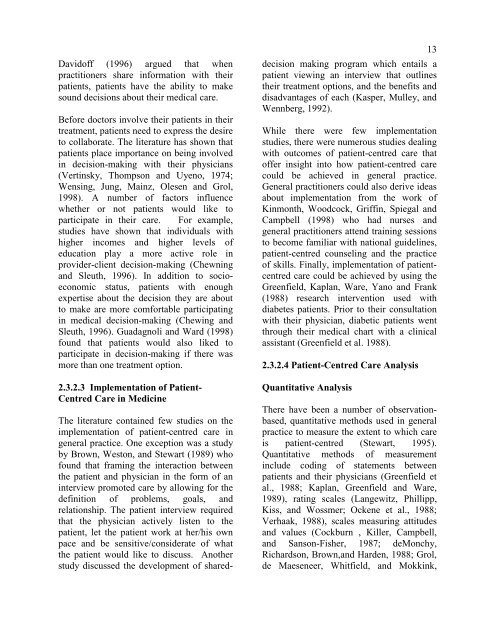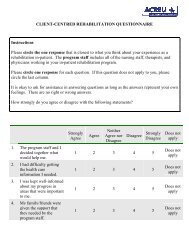Client-Centred Rehabilitation - Arthritis Community Research ...
Client-Centred Rehabilitation - Arthritis Community Research ...
Client-Centred Rehabilitation - Arthritis Community Research ...
Create successful ePaper yourself
Turn your PDF publications into a flip-book with our unique Google optimized e-Paper software.
Davidoff (1996) argued that when<br />
practitioners share information with their<br />
patients, patients have the ability to make<br />
sound decisions about their medical care.<br />
Before doctors involve their patients in their<br />
treatment, patients need to express the desire<br />
to collaborate. The literature has shown that<br />
patients place importance on being involved<br />
in decision-making with their physicians<br />
(Vertinsky, Thompson and Uyeno, 1974;<br />
Wensing, Jung, Mainz, Olesen and Grol,<br />
1998). A number of factors influence<br />
whether or not patients would like to<br />
participate in their care. For example,<br />
studies have shown that individuals with<br />
higher incomes and higher levels of<br />
education play a more active role in<br />
provider-client decision-making (Chewning<br />
and Sleuth, 1996). In addition to socioeconomic<br />
status, patients with enough<br />
expertise about the decision they are about<br />
to make are more comfortable participating<br />
in medical decision-making (Chewing and<br />
Sleuth, 1996). Guadagnoli and Ward (1998)<br />
found that patients would also liked to<br />
participate in decision-making if there was<br />
more than one treatment option.<br />
2.3.2.3 Implementation of Patient-<br />
<strong>Centred</strong> Care in Medicine<br />
13<br />
The literature contained few studies on the<br />
implementation of patient-centred care in<br />
general practice. One exception was a study<br />
by Brown, Weston, and Stewart (1989) who<br />
found that framing the interaction between<br />
the patient and physician in the form of an<br />
interview promoted care by allowing for the<br />
definition of problems, goals, and<br />
relationship. The patient interview required<br />
that the physician actively listen to the<br />
patient, let the patient work at her/his own<br />
pace and be sensitive/considerate of what<br />
the patient would like to discuss. Another<br />
study discussed the development of shareddecision<br />
making program which entails a<br />
patient viewing an interview that outlines<br />
their treatment options, and the benefits and<br />
disadvantages of each (Kasper, Mulley, and<br />
Wennberg, 1992).<br />
While there were few implementation<br />
studies, there were numerous studies dealing<br />
with outcomes of patient-centred care that<br />
offer insight into how patient-centred care<br />
could be achieved in general practice.<br />
General practitioners could also derive ideas<br />
about implementation from the work of<br />
Kinmonth, Woodcock, Griffin, Spiegal and<br />
Campbell (1998) who had nurses and<br />
general practitioners attend training sessions<br />
to become familiar with national guidelines,<br />
patient-centred counseling and the practice<br />
of skills. Finally, implementation of patientcentred<br />
care could be achieved by using the<br />
Greenfield, Kaplan, Ware, Yano and Frank<br />
(1988) research intervention used with<br />
diabetes patients. Prior to their consultation<br />
with their physician, diabetic patients went<br />
through their medical chart with a clinical<br />
assistant (Greenfield et al. 1988).<br />
2.3.2.4 Patient-<strong>Centred</strong> Care Analysis<br />
Quantitative Analysis<br />
There have been a number of observationbased,<br />
quantitative methods used in general<br />
practice to measure the extent to which care<br />
is patient-centred (Stewart, 1995).<br />
Quantitative methods of measurement<br />
include coding of statements between<br />
patients and their physicians (Greenfield et<br />
al., 1988; Kaplan, Greenfield and Ware,<br />
1989), rating scales (Langewitz, Phillipp,<br />
Kiss, and Wossmer; Ockene et al., 1988;<br />
Verhaak, 1988), scales measuring attitudes<br />
and values (Cockburn , Killer, Campbell,<br />
and Sanson-Fisher, 1987; deMonchy,<br />
Richardson, Brown,and Harden, 1988; Grol,<br />
de Maeseneer, Whitfield, and Mokkink,








